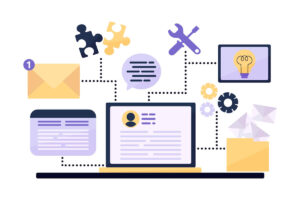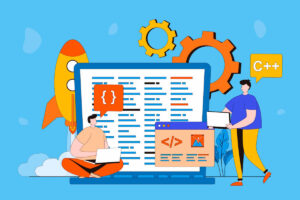In today’s fast-paced digital landscape, innovation is key to staying ahead of the competition. As a Chief Technology Officer (CTO), it’s crucial to leverage the latest technologies and development practices to drive innovation within your organization. Full Stack PHP development is one such approach that can help you achieve this goal.
What is Full Stack PHP Development?
Full Stack PHP development refers to the practice of using PHP programming language for both front-end and back-end development of web applications. This approach allows developers to work on all layers of the application, from the user interface to the server-side logic.
Benefits of Full Stack PHP Development
- Efficiency: By using a single programming language for both front-end and back-end development, developers can streamline their workflow and reduce the time and effort required to build and maintain web applications. This efficiency leads to faster development cycles and quicker time-to-market for new features.
- Flexibility: Full Stack PHP developers have the flexibility to work on all aspects of the application, making it easier to implement changes and updates as needed. This agility allows for rapid iteration and adaptation to changing business requirements.
- Cost-Effective: Since PHP is an open-source language, there are no licensing fees associated with using it for development. This can result in cost savings for organizations looking to build web applications on a budget. Additionally, the vast community support and resources available for PHP development further contribute to its cost-effectiveness.
Best Practices for Full Stack PHP Development
To drive innovation with Full Stack PHP development, CTOs should consider implementing the following best practices:
- Use a Framework: Leveraging a PHP framework, such as Laravel or Symfony, can help streamline development and ensure code consistency across the application. Frameworks provide ready-made solutions for common web development tasks, reducing development time and effort.
- Implement Test-Driven Development: By writing tests before writing code, developers can ensure that their application meets the desired requirements and functions as expected. This practice leads to higher code quality, fewer bugs, and overall better maintainability of the application.
- Follow Security Best Practices: Security should be a top priority in web development. CTOs should ensure that developers follow best practices for securing PHP applications, such as using secure coding practices and regularly updating dependencies. Implementing security measures from the start can prevent potential vulnerabilities and protect sensitive data.
- Utilize DevOps Practices: Implementing DevOps practices, such as continuous integration and continuous deployment, can help streamline the development process and ensure a seamless deployment of web applications. By automating testing, building, and deployment processes, DevOps practices enable faster release cycles and improved collaboration between development and operations teams.
Case Studies: How Full Stack PHP Development Drives Innovation
Case Study 1: E-commerce Website
A leading e-commerce company implemented Full Stack PHP development for their online store. By using PHP for both front-end and back-end development, they were able to quickly iterate on new features and enhancements, resulting in a more user-friendly and responsive website. The flexibility of PHP allowed them to easily integrate third-party APIs for payment processing and shipping, enhancing the overall user experience.
Case Study 2: SaaS Application
A software-as-a-service (SaaS) company adopted Full Stack PHP development for their cloud-based application. With PHP’s flexibility and efficiency, they were able to scale their application rapidly to meet the growing demands of their customers, driving innovation within their industry. The company leveraged PHP frameworks for rapid prototyping of new features and utilized automated testing to ensure the reliability and performance of their application.
Conclusion
Full Stack PHP development offers CTOs a powerful tool to drive innovation within their organizations. By leveraging the benefits of PHP and following best practices, CTOs can build scalable, secure, and efficient web applications that keep pace with the ever-changing digital landscape. Embracing Full Stack PHP development can help CTOs stay ahead of the competition and drive innovation within their organizations.
Want to learn more about how Full Stack PHP development can benefit your organization? Contact us today for a free consultation.
FAQs:
What is Full Stack PHP Development?
Full Stack PHP development refers to the practice of using PHP programming language for both front-end and back-end development of web applications. This approach allows developers to work on all layers of the application, from the user interface to the server-side logic.
What are the benefits of Full Stack PHP Development?
- Efficiency: By using a single programming language for both front-end and back-end development, developers can streamline their workflow and reduce the time and effort required to build and maintain web applications.
- Flexibility: Full Stack PHP developers have the flexibility to work on all aspects of the application, making it easier to implement changes and updates as needed.
- Cost-Effective: Since PHP is an open-source language, there are no licensing fees associated with using it for development. This can result in cost savings for organizations looking to build web applications on a budget.
What are the best practices for Full Stack PHP Development?
- Use a Framework: Leveraging a PHP framework, such as Laravel or Symfony, can help streamline development and ensure code consistency across the application.
- Implement Test-Driven Development: By writing tests before writing code, developers can ensure that their application meets the desired requirements and functions as expected.
- Follow Security Best Practices: Security should be a top priority in web development. CTOs should ensure that developers follow best practices for securing PHP applications, such as using secure coding practices and regularly updating dependencies.
- Utilize DevOps Practices: Implementing DevOps practices, such as continuous integration and continuous deployment, can help streamline the development process and ensure a seamless deployment of web applications.
How does Full Stack PHP Development drive innovation?
Full Stack PHP Development drives innovation by allowing developers to work on all aspects of web applications, from front-end to back-end, ensuring efficiency, flexibility, and cost-effectiveness. By following best practices and utilizing frameworks and DevOps practices, CTOs can leverage Full Stack PHP Development to stay ahead of the competition and drive innovation within their organizations.












+ There are no comments
Add yours